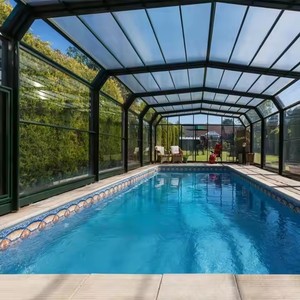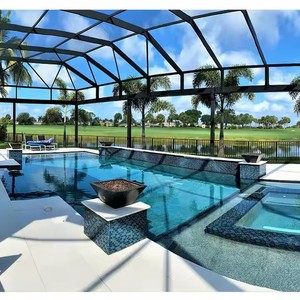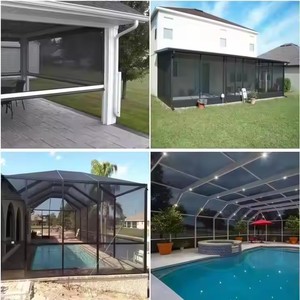(49 products available)

































































































































































































































An above-ground pool screen enclosure is a structure built around a pool to keep out debris, insects, and animals. It provides a clean and safe swimming environment. There are different types of pool enclosures, which include:
Removable screen enclosures
Removable screen enclosures are not permanent. They are ideal for people who want to try out pool enclosures. These enclosures are simple to install and take out when necessary. They are perfect for small pools since they are less costly. They come in different sizes, which can be tailored to fit any pool. They also have different styles, so owners can pick what best suits their taste.
Permanent pool screen enclosures
As the name suggests, these enclosures remain intact. They are built using sturdy materials like aluminum or steel. They provide more protection against bugs and debris since they have a tight screen fit. Permanent enclosures also have more customization choices. Owners can pick additional features like rooms or patios. Installing permanent enclosures requires professional help.
Inflatable pool screen enclosures
These are the easiest to set up since no tools are required. Owners must fit the enclosure's parts, ensuring everything is firm and tight. Then, inflate the enclosure using a pump and secure it to the ground using pegs or stakes. Inflatable enclosures are spacious and airy since they use thin mesh material. They are also versatile since they can fit different-sized pools. Another advantage of inflatable enclosures is that they are lighter and more portable. This makes it easy to move them to different locations or transfer them to new pools.
Hybrid pool screen enclosures
These enclosures combine different materials and styles. They are flexible since they can be customized to fit different pools and landscapes. Hybrid enclosures have unique designs that make them visually appealing. They also use different materials, making them more durable.
Metal frame pool screen enclosures
These enclosures have a metal frame, usually from aluminum or steel. The frames are lightweight and resistant to rust and bad weather. Metal frame enclosures are durable and need little maintenance. The metal frames also create a solid structure that can resist wind and other forces.
Thatched roof pool screen enclosures
These enclosures have a roof made from woven natural materials like palm leaves. They look good and provide a unique atmosphere. Thatched roof enclosures allow light to come in while keeping bugs and debris out. They also have good ventilation since the walls are made of mesh.
Durability:
Above-ground pool enclosures are built using long-lasting materials like aluminum, which do not rust, and special screens that resist tearing. This helps ensure the enclosures last a long time without falling apart. Even though the enclosures are lightweight and easy to move, they can withstand strong winds and heavy rains without breaking or being damaged. Their durability keeps the pool covered and safe for swimming year-round.
Weather resistance:
Above-ground pool enclosures can withstand different kinds of weather very well. They are made with materials that do not rust or get damaged from exposure to water, so the pool remains safe even when it rains a lot or there are strong winds. The mesh screens used on the enclosures do not tear easily, and the framework supports are stable, preventing problems due to changing temperatures or high winds.
Protection from debris and pests:
Above-ground pool enclosures shield the pool from natural debris like leaves, twigs, and insects. The mesh screens trap and prevent small bugs and other animals from falling into the water, keeping the pool cleaner and reducing the need to skim it daily. Fewer insects around also mean less worry about getting bitten while swimming.
Enhanced safety:
Safety is an important part of protecting the pool and all who use it. The enclosures create walls that stop kids and pets from accidentally falling into the water. This gives parents and pool owners peace of mind since they do not have to worry as much about dangerous slips or falls into the pool, especially with young children or animals around.
Easy access and ventilation:
The pool enclosures provide simple ways for people to enter and exit the space while still shielding the water from the outside. There are doors or sections that can be lifted so that swimmers can go in and out without difficulty. Even though the doors close off the pool area, the mesh screens allow air to flow through. This ventilation keeps the atmosphere inside from feeling stuffy.
Customizable size and design:
No matter the dimensions or shape of the pool, an enclosure can be made to fit perfectly. The enclosures are also designed in different styles, so one will match the look of the home and yard. Pool owners get to pick what works best for them.
There are several scenarios where an above-ground pool screen enclosure is applicable. This includes:
Safety
An pool enclosure helps keep children and animals away from the pool, which prevents unintentional falls or accidents. It's a good idea to get one with a door that locks.
Materials
Enclosures are often made of aluminum, which doesn't rust and is lightweight but strong. Another choice is metal framing with toughened glass panels. Both materials last a long time.
Climate
In windy areas, strong materials that can resist the wind should be picked. Wind tunnels can be made between pools and their surroundings, so enclosures should be sturdy enough to stay solid and not fall over.
Size and shape of the pool
The enclosure should be able to fit over the pool properly. Measure the pool's length, width, and depth so a suitable cover can be bought. Consider also the pool's form - rectangular, circular, or other shapes.
Enclosures come in many sizes and shapes to match pools of all dimensions and layouts.
Aesthetics
It's important that the enclosure looks nice to enhance the appearance of the pool and home. Consider how the style, materials, and color of the enclosure will match the house and garden.
Cost
A higher-priced enclosure may need to be purchased to get more quality and features that provide better protection for the pool. The amount available to spend should be decided before looking at different options.
Permits
It must be confirmed that a permission is not required before building an enclosure. Some places require permits for safety reasons, so the local laws should be checked.
Q1: What are the benefits of above-ground pool screen enclosures?
A1: Pool enclosures keep debris out, reducing the time spent cleaning the pool and minimizing health risks from waterborne germs. They also help maintain water levels and reduce chemical loss due to evaporation. Enclosures offer a safe swimming environment, protecting both kids and pets from accidental falls into the water. They also create a private oasis, shielding the pool area from prying eyes.
Q2: What are the types of pool enclosures?
A2: There are three main types. Solar enclosures trap heat from the sun, making them ideal for warmer climates. Mesh enclosures have walls made of mesh, which allows airflow but keeps out debris and insects. Solid wall enclosures provide the most privacy and protection but may not circulate air as well as other types.
Q3: How does a retractable pool enclosure work?
A3: Retractable enclosures are mounted on tracks installed on the ground. Users can slide the enclosure open or closed, similar to patio doors, using a simple glide system. Some designs have automatic tracks that move the enclosure with the push of a button.
Q4: What materials are used to build pool enclosures?
A4: The frame is usually made of durable materials like aluminum or galvanized steel. The walls may be solid polycarbonate panels or mesh screens. Polycarbonate panels are preferred for their strength and ability to block UV rays while letting sunlight in.
Q5: How much does it cost to build a pool enclosure?
A5: On average, a basic pool enclosure costs around $5,000. However, prices can go up to $30,000 or more for higher-end solid wall enclosures. Factors affecting cost include the size of the pool, materials used, and any additional features like lighting or heating.